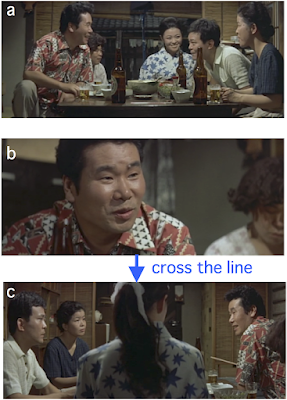Saturday, November 14, 2015
How to break the 180-degree rule in your desired intensity
Posted by
masayuki nakazawa
at
10:38 AM
Steamboat round the bend (John Ford, 1935)At first, Dr. John (Will Rogers) and Fleety (Anne Shirley) are at loggerheads over the marriage between his nephew and her. After driving away guys who tried to take her back, their relationship starts to improve. How did John Ford depict this decisive moment?
a) He is puzzled by driving them away before he knew what he was doing.
b) She gazes at him facing left.
c) He is on the screen left. She is on the screen right.
d) She gazes at him facing right.
e) He is on the screen right. She is on the screen left.
John Ford broke the 180-degree rule from c to d. Viewers get disoriented and confused like them because their relationship totally changed and it hasn't sunk in yet. We cross the 180-degree line just when Fleety does a 180 degree turn. Comparing b with d, she faces in the opposite direction. Comparing c with e, the backgrounds are completely different. As I mentioned in the previous entry, crossing the 180-degree line during a shot changes viewer's view dramatically. But you can also give viewers the feeling of disorientation by crossing the 180-degree line from shot to shot. The thing is, it's just a temporary violation. After breaking the rule from c to d, John Ford resumes following the rule within a new 180-degree arc before viewers realize the rule was broken. That makes viewers assume the dramatic change and disorientation come from her acting.
The Angel's Egg(Shin Togashi, 2006)
This scene opens with the profiled two-shot in which Ayuta (Hayato Ichihara) and Natsuki (Erika Sawajiri) chatter in a cafe (a). By crossing the 180-degree line (a-b), we (it's my work as a cinematographer) cut to the next shot in which she suddenly gets to the point. This reverse cutting mainly offers the change of lighting like Promised Land, the different side of face like The Holiday and the feeling of disorientation like Steamboat round the bend . But viewers are not puzzled as much as Steamboat round the bend. Since I filmed the shot of her as over-the-shoulder shot (b), viewers can reorient themselves relative to his shoulder unlike the single shot of Anne Shirley (d) in Steamboat round the bend.
Tora-san's Runaway (Yoji Yamada, 1970)
This is from one of the Japanese movie series (48 installments) called Tora-san. Tora-san (Kiyoshi Atsumi) realizes that his love is hopeless in this scene. How did Yoji Yamada depict the decisive moment?
He depicted Tora-san's upset by crossing the 180-degree line (b-c). However, viewer's reorientation is way easier than Steamboat round the bend and The Angel's Egg. Unlike them, the consecutive shot is a new establishing shot which defines the opposite 180-degree arc (c).
Conclusion
We can use the effect of disorientation coming from breaking the rule and control the intensity by crossing the line:
0) during a shot (No disorientation) ex. The Champ / Promised Land / The Holiday / Heat
1) to the consecutive shot that is wide enough to establish a new 180-degree arc (min) ex. Tora-san's Runaway
2) to the consecutive shot that is taken over-the-shoulder ex. The Angel's Egg
3) to the consecutive shot that is close up to a single person (max) ex. Steamboat round the bend
Regardless of how much the intensity is, it is just a temporary violation. For the violation to be temporary, it is crucial to keep the rule other than the right timing and the right reason.
Subscribe to:
Post Comments
(
Atom
)









No comments :
Post a Comment